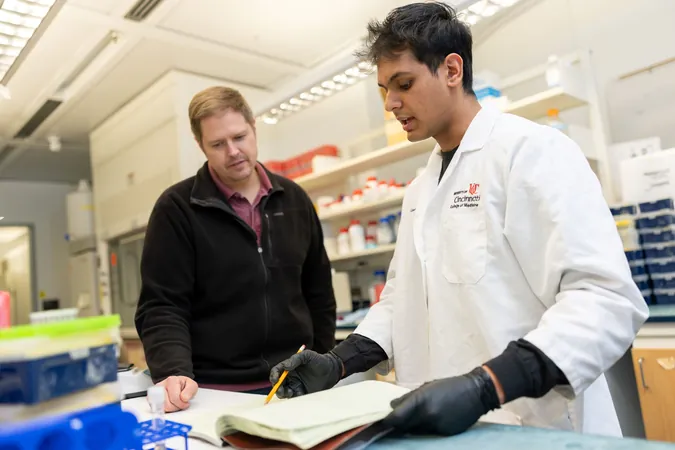
Unlocking the Secrets of Precision Medicine: Insights from Billions of Years of Evolution
2025-07-08
Author: Li
A Bold Journey into the Past
Imagine peering billions of years into the depths of evolutionary history to uncover groundbreaking insights for the future of precision medicine. That's precisely what researchers at the University of Cincinnati Cancer Center have achieved. Led by PhD student Bibek R. Karki and senior author Tom Cunningham, this pioneering study, published in *Nature Communications*, explores the enigmatic PRPS enzyme complex, revealing its crucial role in cellular biochemistry.
The Mystery of PRPS Enzymes Unveiled
The spotlight is on a vital metabolic enzyme known as phosphoribosyl pyrophosphate synthetase (PRPS). Mammalian cells boast four variants: PRPS1, PRPS2, and two associated proteins, AP1 and AP2. While extensive research has concentrated on standalone PRPS1 and PRPS2, the roles of AP1 and AP2 have remained cryptic, leading Karki to describe them as 'zombie' enzymes—existing yet seemingly inactive.
Why Keep the 'Zombie' Enzymes?
Curiosity drove the researchers to dig deeper into why genes for these supposedly dormant proteins have endured throughout evolutionary history. Karki explains, "If a gene is evolutionarily conserved, it means it’s repeatedly favored by nature, indicating it must be doing something significant." Thus, the team set out to uncover the hidden potential of AP1 and AP2.
Tracing the Evolutionary Path
To unravel the functions of AP1 and AP2, researchers traced the evolutionary lineage of PRPS genes. They discovered that PRPS1 was introduced into eukaryotes from a bacterial donor billions of years ago, paving the way for AP2's emergence over a billion years ago, followed by the evolution of AP1 and PRPS2 through a genomic duplication event.
The Importance of Enzyme Complexes
Karki emphasizes the preservation of these proteins across diverse species—from sharks to mammals—showcasing their critical biological importance. The study revealed that multiple PRPS-encoding genes are nearly universal in eukaryotes, an intriguing divergence from bacteria, hinting at a vital function in metabolic adaptation.
Revealing the Enzyme Interplay
Employing CRISPR gene editing, the team knocked out various combinations of these enzymes in mammalian cells, finding a substantial decline in the cells' overall fitness—even more pronounced in those with just PRPS1. The larger enzyme complex's integrity was shown to hinge on AP1 and AP2, which act as structural scaffolds crucial for stability.
A Shift in Research Perspective
This research challenges the narrative of studying PRPS1 alone, as it leads to an incomplete understanding. Karki states, "Studying these proteins in isolation only gives you part of the story." Emphasizing the importance of analyzing all four proteins together, the team aims to unlock the intricate details governing enzyme activity and regulation.
Implications for Future Treatments
With a clear link established between PRPS enzymes and various diseases, including certain cancers, understanding the complete functionality of the PRPS complex could herald new therapeutic avenues. As Cunningham points out, regulating PRPS activity might offer strategies to tackle tumor growth or address nucleotide deficiency syndrome.
The Road Ahead
This monumental study lays the groundwork for innovative diagnostics and therapies that could transform patient health. By harnessing the wisdom from evolutionary history, scientists are poised to craft personalized medical treatments tailored to individual needs, pushing the boundaries of what precision medicine can achieve.

 Brasil (PT)
Brasil (PT)
 Canada (EN)
Canada (EN)
 Chile (ES)
Chile (ES)
 Česko (CS)
Česko (CS)
 대한민국 (KO)
대한민국 (KO)
 España (ES)
España (ES)
 France (FR)
France (FR)
 Hong Kong (EN)
Hong Kong (EN)
 Italia (IT)
Italia (IT)
 日本 (JA)
日本 (JA)
 Magyarország (HU)
Magyarország (HU)
 Norge (NO)
Norge (NO)
 Polska (PL)
Polska (PL)
 Schweiz (DE)
Schweiz (DE)
 Singapore (EN)
Singapore (EN)
 Sverige (SV)
Sverige (SV)
 Suomi (FI)
Suomi (FI)
 Türkiye (TR)
Türkiye (TR)
 الإمارات العربية المتحدة (AR)
الإمارات العربية المتحدة (AR)